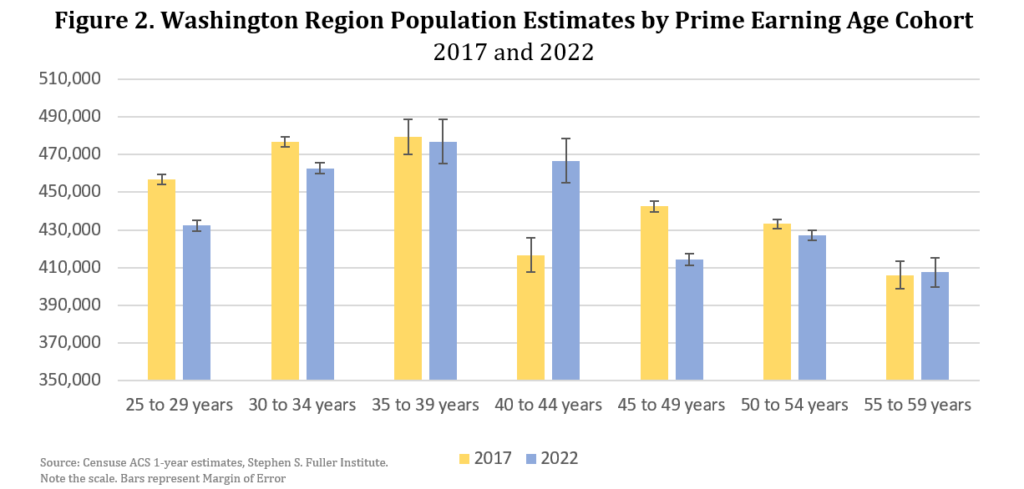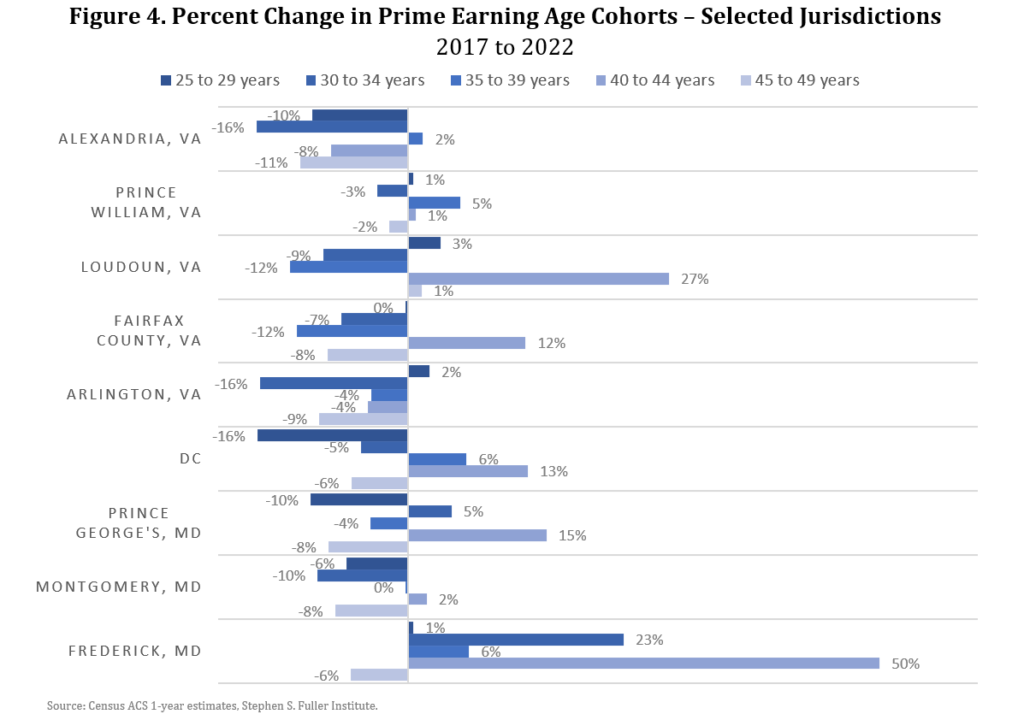REGIONAL ECONOMIC NOTE No. 24-2
Keith Waters and Terry Clower
Download Full Economic Note as a PDF >>
In a previous regional economic note, we observed that the labor forces of DC and Suburban Maryland have declined in the wake of the pandemic. While this decline could have occurred for any of many reasons, one plausible factor is that some prime earning age workers have left the region, leaving a population that is disproportionately large in children and older adults. This post examines age distribution of the Washington region. The most concerning finding is that the number of people 30 to 39 declined in the Washington region from 2017 to 2022, while the same population increased nationally over the same period. Furthermore, the youngest cohort, under five years old, shrank from 2017 to 2022. Historically speaking, workers in their 20s tend to move more frequently for school and jobs, but in their 30s they are forming families, having children, and “putting down roots” in their community that can discourage later out-migration. Unfortunately for Greater Washington, data suggests that the region is not competitive for the mid-career population. A recent report by the Comptroller of Maryland offers a plausible basis by noting that housing and childcare costs are key issues for retaining and attracting workers from young families.[1]
A note on the data before proceeding. This post examines data from 2017 to 2022. These years were chosen to capture shifts due to the pandemic. However, they were also chosen as the age cohorts reported by the Census Bureau are five-year cohorts. Given this, the entire cohort in the 2017 sample will have aged into the next cohort in the 2022 sample. However, given that the data are simply population estimates, there are several reasons cohorts change. The population of any cohort may change from any combination of aging into older cohorts, changes in migration patterns, and natural change (births and deaths).
Age Distributions in the Washington Region
Overall, the Washington region got older from 2017 to 2022. The median age of the Washington region increased from 37.1 (±0.1 MOE) in 2017 to 38.2 (±0.2 MOE) in 2022. The increase in the median age was driven primarily by two forces, an increase in the number of people over 60 years old and a decrease in the working age population (Figure 1). From 2017 to 2022, the population 60 years and older increased by 170,354 from 1.13 million to 1.30 million (+15%). Furthermore, the number of people in every 5-year age category over 60 increased from 2017 to 2022, with the largest increase being a 40,229-person increase in the population ages 70 to 74 (+20.1%). Meanwhile, the working age population (20 to 59 years) declined 23,407 from 3.11 million to 3.08 million (-0.8%). Finally, while the population under 20 years increased from 2017 to 2022, the population under 5 years old declined by 6.4% over the period.

Given the contraction in sub-regional labor forces (here), it is worth examining the prime earning age cohorts more closely (Figure 2). In level and percentage terms, the population 45 to 49 years old declined the most, decreasing by 28,091 people (-6.3%). This was followed by the population 25 to 29 years old and the population 30 to 34 years old, which declined by 24,482 people (-5.4%) and 13,879 people (-2.9%), respectively. Interestingly, the population 40 to 44 years old grew sharply, increasing from 416,695 in 2017 to 466,642 in 2022 (+49,947; +12.0%). Given that the ACS is sample data, the Margins of Error (MOE) are provided for the sample estimates. Note that apart from the population 35 to 39 years and the population over 50, the changes in the 5-year cohorts are outside of the MOE, suggesting real changes over the period that are not simply the result of sampling variation.

While the declines in certain age cohorts should concern local leaders, it may be the case that the changes in the population are not isolated to the Washington region. To examine this possibility, the Washington region is compared to national population trends (Figure 3). Unfortunately, the decline in the population 30 to 39 years in the Washington region stands in sharp contrast with national trends. From 2017 to 2022, the population in the Washington region 30 to 34 and 35 to 39 declined 2.9 percent and 0.5 percent, respectively. Meanwhile, the same age cohorts grew nationally 6.2 percent and 4.5 percent, respectively. While other cohorts broadly match national trends, it is also notable that while the population in the US 55 to 59 years old declined 5.6 percent from 2017 to 2022, the same population in the Washington region increased 0.4 percent. The Washington region is underperforming the US notably in competing for younger prime working-age populations, with negative implications for labor force availability and economic growth for decades as these workers put down roots in other metro areas.

Examining prime earning age populations in select DC jurisdictions reveals a distinct shift from the core to the periphery of the MSA, notwithstanding sampling variability (Figure 4). While the District recorded gains in the cohort 40 to 44 years along with the region, it also recorded gains in the population 35 to 39 years old, an outlier among other core jurisdictions such as Arlington and Alexandria. Arlington and Alexandria, arguably the two other super-core jurisdictions, saw nearly across-the-board population declines in the prime earning age cohorts. With the exceptions of a small increase in the population age 35 to 39 years for Alexandria and the population 25 to 29 years for Arlington, these jurisdictions recorded population losses in every other prime earning age cohort. The two largest suburban counties, Montgomery and Fairfax, recorded large declines in the youngest working age cohorts and those 45 to 49 years. Fairfax County, however, recorded a large population decline in the cohort 35 to 39 (-12%) and a large increase in the cohort 40 to 44 (+12%). Montgomery County, in contrast, recorded nearly no population change in either the 35 to 39 cohort or the 40 to 44 cohort, despite the losses in the remaining cohorts. While Loudoun and Frederick County both recorded large increases in the 40 to 44 cohort, Loudoun recorded notable losses in the younger cohorts while Frederick recorded notable gains in the population 30 to 39. In fact, Frederick only lost population in the cohort 45 to 49. Loudoun and Frederick were the only two counties to increase population among prime earning age cohorts, with Loudoun gaining 2 percent and Frederick gaining a remarkable 13 percent. Setting aside sampling variability, the data show a clear trend out of the core jurisdictions into outer jurisdictions, particularly among the population 40 to 49.

Conclusion
The Washington region’s median age increased from 37.1 from 2017 to 38.2 in 2022. While the US median age also increased over this period, the way in which the Washington region changed differed markedly. The population in the Washington region over 60 years old increased while the prime earning age population declined. Although three of the four cohorts under 20 increased from 2017 to 2022, the youngest cohort, the population under 5 years old declined. Comparing the percent change in prime earning age cohorts in the Washington region to the US from 2017 to 2022 reveals that while the population 30 to 39 years declined in the Washington region, it increased nationally. Examining prime earning age cohorts within the region reveals a general shift from the core of the Washington region to the outer jurisdictions, particularly among the population in their 40s.
Overall, the data suggest that the Washington region appears unable to attract or retain the population in their prime working years, particularly core jurisdictions. The fact that the population under 5 years old also declined from 2017 to 2022 supports the widely held view that young families in their 30s are unable to afford family-sized homes and childcare and are leaving for less expensive regions. If these trends continue, regional employers may be forced to relocate job openings elsewhere in search of young workers entering their prime years. These trends are deeply troubling for the region’s economic competitiveness.
About These Data
The reported data come from the U.S. Census Bureau, American Community Survey (ACS) ACS 1-year, from 2017 and 2022.
[1] Comptroller of Maryland. Maryland State of the Economy. 2023.
